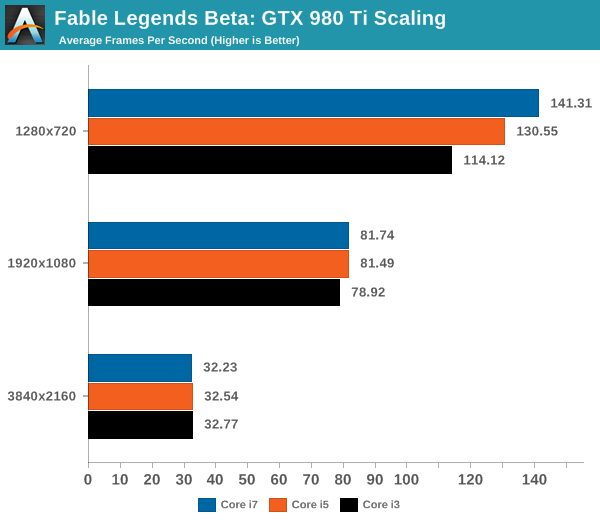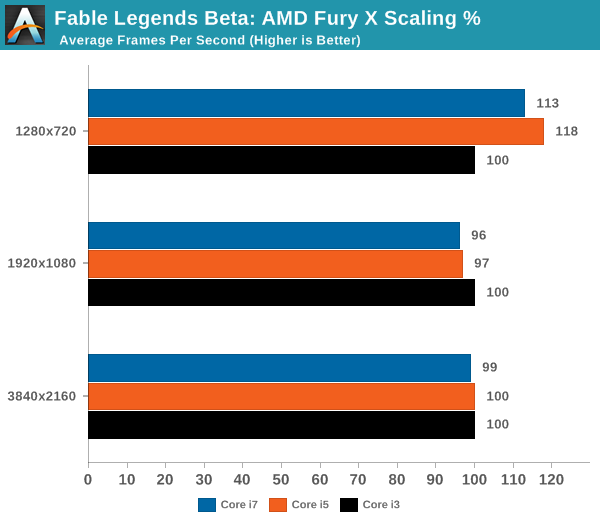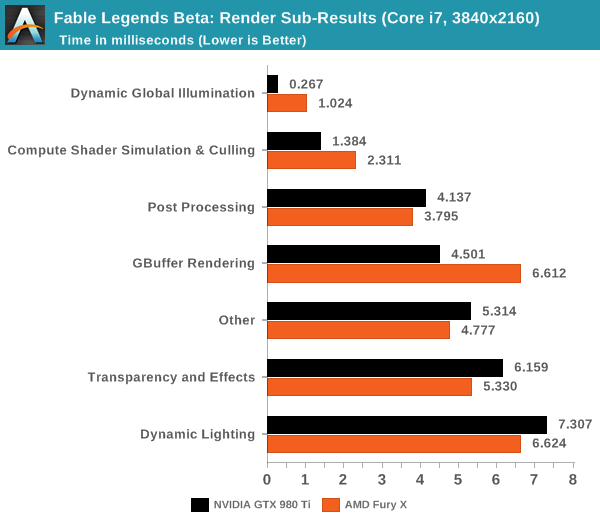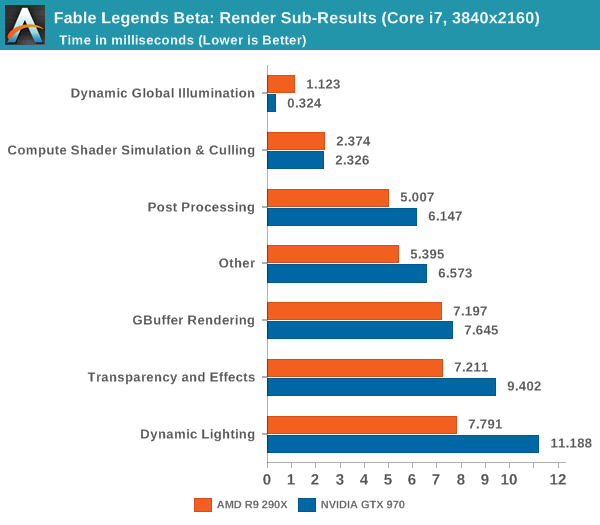Fable Legends Early Preview: DirectX 12 Benchmark Analysis
by Ryan Smith, Ian Cutress & Daniel Williams on September 24, 2015 9:00 AM ESTCPU Scaling
When it comes to how well a game scales with a processor, DirectX 12 is somewhat of a mixed bag. This is due to two reasons – it allows GPU commands to be issued by each CPU core, therefore removing the single core performance limit that hindered a number of DX11 titles and aiding configurations with fewer core counts or lower clock speeds. On the other side of the coin is that it because it allows all the threads in a system to issue commands, it can pile on the work during heavy scenes, moving the cliff edge for high powered cards further down the line or making the visual effects at the high end very impressive, which is perhaps something benchmarking like this won’t capture.
For our CPU scaling tests, we took the two high end cards tested and placed them in each of our Core i7 (6C/12T), Core i5 (4C/4T) and Core i3 (2C/4T) environments, at three different resolution/setting configurations similar to the previous page, and recorded the results.


Looking solely at the GTX 980 Ti to begin, and we see that for now the Fable Benchmark only scales at the low resolution and graphics quality. Moving up to 1080p or 4K sees similar performance no matter what the processor – perhaps even a slight decrease at 4K but this is well within a 2% variation.


On the Fury X, the tale is similar and yet stranger. The Fable benchmark is canned, so it should be running the same data each time – but in all three circumstances the Core i7 trails behind the Core i5. Perhaps in this instance there are too many threads on the processor contesting for bandwidth, giving some slight cache pressure (one wonders if some eDRAM might help). But again we see no real scaling improvement moving from Core i3 to Core i7 for our 1920x1080 and 3840x2160.

As we’ve seen in previous reviews, the effects of CPU scaling with regards resolution are dependent on both the CPU architecture and the GPU architecture, with each GPU manufacturer performing differently and two different models in the same silicon family also differing in scaling results. To that end, we actually see a boost at 1280x720 with the AMD 7970 and the GTX 680 when moving from the Core i3 to the Core i7.
If we look at the rendering time breakdown between GPUs on high end configurations, we get the following data. Numbers here are listed in milliseconds, so lower is better:

Looking at the 980Ti and Fury X we see that NVIDIA is significantly faster at GBuffer rendering, Dynamic Global Illumination, and Compute Shader Simulation & Culling. Meanwhile AMD pulls narrower leads in every other category including the ambiguous 'other'.

Dropping down a couple of tiers with the GTX 970 and R9 290X, we see some minor variations. The R9 290X has good leads in dynamic lighting, and 'other', with smaller leads in Compute Shader Simulation & Culling and Post Processing. The GTX 970 benefits on dynamic global illumination significantly.
What do these numbers mean? Overall it appears that NVIDIA has a strong hold on deferred rendering and global illumination and AMD has benefits with dynamic lighting and compute.










141 Comments
View All Comments
piiman - Saturday, September 26, 2015 - link
"Yes, but when the goal is to show improvements in rendering performance"I'm completely confused with this "comparison"
How does this story even remotely show how will Dx12 works compared to Dx11? All they did was a Dx12 VIDEO card comparison? It tells us NOTHING in regard to how much faster Dx12 is compared to 11.
inighthawki - Saturday, September 26, 2015 - link
I guess what I mean is the purpose of a graphics benchmark is not to show real world game performance, it is to show the performance of the graphics API. This this case, the goal is trying to show that D3D12 works well. Throwing someone into a 64 player match of battlefield 4 to test a graphics benchmark defeats the purpose because you are introducing a bunch of overhead completely unrelated to graphics.figus77 - Monday, September 28, 2015 - link
You are wrong, many dx12 implementation will help on very chaotic situation with many pg and big use of IA, this benchmark is usefull like a 3dmark... just look at the images and say is a nice graphics (still Witcher3 in DX11 is far better for me)inighthawki - Tuesday, September 29, 2015 - link
I think you missed the point - I did not say it would not help, I just said that throwing on tons of extra overhead does not isolate the overhead improvements on the graphics runtime. You would get fairly unreliable results due to the massive variation caused by actual gameplay. When you do a benchmark of a specific thing - e.g. a graphics benchmark, which is what this is, then you want to perform as little non-graphics work as possible.mattevansc3 - Thursday, September 24, 2015 - link
Yes, the game built on AMD technology (Mantle) before being ported to DX12, sponsored by AMD, made in partnership with AMD and received development support from AMD is a more representative benchmark than a 3rd party game built on a hardware agnostic engine.YukaKun - Thursday, September 24, 2015 - link
Yeah, cause Unreal it's very neutral.Remember the "TWIMTBP" from 1999 to 2010 in every UE game? Don't think UE4 is a clean slate coding wise for AMD and nVidia. They will still favor nVidia re-using old code paths for them, so I'm pretty sure even if the guys developing Fable are neutral (or try to), UE underneath is not.
Cheers!
BillyONeal - Thursday, September 24, 2015 - link
That's because AMD's developer outreach was terrible at the time, not because Unreal did anything specific.Kutark - Monday, September 28, 2015 - link
Yes, but you have to remember, Nvidia is Satan, AMD is Jesus. Keep that in mind when you read comments like that and all will make senseStuka87 - Thursday, September 24, 2015 - link
nVidia is a primary sponsor of the Unreal Engine.RussianSensation - Thursday, September 24, 2015 - link
UE4 is not a brand agnostic engine. In fact, every benchmark you see on UE4 has GTX970 beating 290X.I have summarized the recent UE4 games where 970 beats 290X easily:
http://forums.anandtech.com/showpost.php?p=3772288...
In Fable Legends, a UE4 DX12 benchmark, a 925mhz HD7970 crushes the GTX960 by 32%, while an R9 290X beats GTX970 by 13%. Those are not normal results for UE4 games that have favoured NV's Maxwell architecture.
Furthermore, we are seeing AMD cards perform exceptionally well at lower resolutions, most likely because DX12 helped resolve their DX11 API draw-call bottleneck. This is a huge boon for GCN moving forward if more DX12 games come out.
Looking at other websites, a $280 R9 390 is on the heels of a $450 GTX980.
http://techreport.com/review/29090/fable-legends-d...
So really besides 980Ti (TechReport uses a heavily factory pre-overclocked Asus Strix 980TI that boosts to 1380mhz out of the box), the entire stack of NV's cards from $160-500 loses badly to GCN in terms of expected price/performance.
We should wait for the full game's release and give NV/AMD time to upgrade their drivers but thus far the performance in Ashes and Fable Legends is looking extremely strong for AMD's cards.